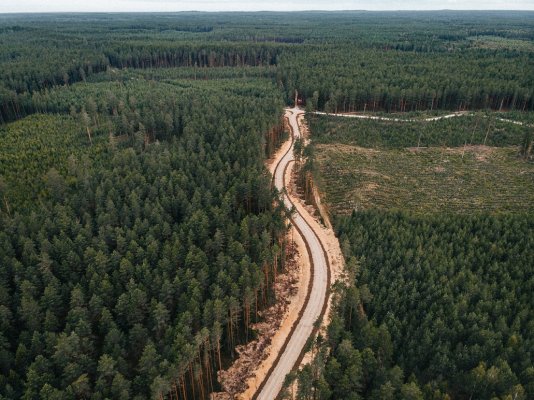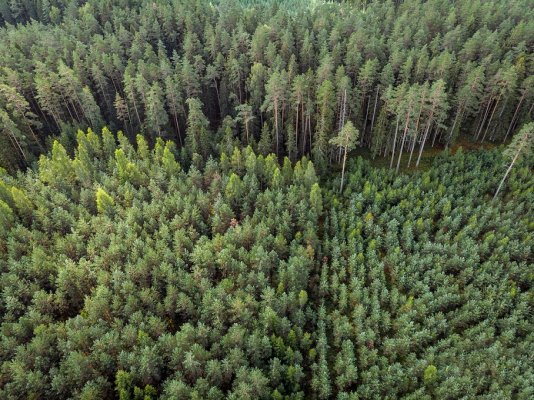What is Today's Forest Like? The National Forest Monitoring Answers This Question
At the end of the past decade, a five-year cycle of the National Forest Monitoring came to an end, starting the next – the fourth cycle. The National Forest Monitoring is performed by the Latvian State Forest Research Institute “Silava”. The data obtained in the monitoring show what the Latvian forest is like in terms of its wood resources, productivity and health, as well as allows us to look into the future or to model what it will be like in 50 or even 100 years.
Latvia is a forest land – if people did not live in the territory of the country, almost 96% of its inland territory would be covered by forest. The remaining area would be bogs, rivers, lakes and, to a lesser extent, floodplain meadows. But people do live in Latvia. In order to create a place for growing food and living, over the centuries, people have cut down forests, until forest cover decreased to 27% during the first free state of Latvia. Both after the Second World War and after the restoration of the country's independence, the forest area increased again, and now forests cover more than half of the country's inland area. In addition to eating and living, people have always used the direct services provided by the forest ecosystem in various ways, including felling trees, making and using various wood products. The result of this interaction is also revealed by the National Forest Monitoring. It is a kind of demographic portrait of the forest. In the course of monitoring, chronological information is obtained on changes in the forest area, the structure and dynamics of forest wood resources, damage to forest stands, dead wood and wood used by people. Scientific monitoring of forest pests and diseases is also performed in order to obtain operative information on the prevalence of the most dangerous forest pests and diseases and its forecasts.
What grows in today's forest
According to the latest monitoring data of five years, birch is the currently dominant tree species in Latvian forests, more precisely, two birch species – downy birch and silver birch. “The fact that birch has “dethroned” the previously dominant species – pine is, in fact, neither bad nor alarming – the national timber industry relies very seriously on birch wood resources. This tendency rather makes us pay more attention to the quality of birches, because for the time being the growth of this species in Latvian forests can be explained more by the regeneration of forest stands – birch stands bind and grow together, rather than being purposefully restored,” says Jurģis Jansons, Director of the Latvian State Forest Research Institute “Silava”. It would be much sadder if grey alder regenerated on a large scale – trees of this species can only grow up to the age of 30–50 years, after which grey alder dies biologically. However, the triumph of birches does not mean that the proportion of pine or spruce would decrease significantly – they are still the next two dominant tree species in Latvian forests. If the government accepted the changes in the regulatory environment proposed by the forest sector, forest owners would be more motivated to regenerate forest stands with conifers and thus the age of forest stands and the quality of wood resources would increase.
Future forecasts
The National Forest Monitoring also allows you to look into the forest of the future. Based on a targeted forestry scenario, it can be expected that in the near future the volume of wood from living trees growing in the forest will be 10–15 million cubic metres more than now; in 50 years, this additional benefit will be about 30 million, but in 100 years – already 90 million cubic metres of additional wood in growing forest stands.
If the recommendations of scientists to take more intensive care of forest stands at a young age, but to do so more carefully at an older age are followed, in the future, there will be more and thicker trees in the main felling and, consequently, more cubic metres of wood. “The outlook for the future is encouraging – targeted forest management will make forests more productive and will not reduce the age of forests – it will be an average of 45–50 years in commercial forests, and at least as many 100-year-old forests will remain,” says Guntars Šņepsts, Head of the Forest Forecasting System at the Latvian State Forest Research Institute “Silava”.
High biodiversity rates
The National Forest Monitoring also gives us a clear and affirmative answer that neither now nor in the foreseeable future will biodiversity in Latvia's forests decrease. In Latvia as a whole, biodiversity is high, and it is so thanks to the forestry practices applied so far – saw log movement, small felling, extremely careful, in the European sense – even old-fashioned planning of the main felling volumes, as well as purposefully created and maintained network of nature protection areas. Many components of biodiversity conservation and enhancement are also integrated into day-to-day forestry. The most typical example is the preservation of the previous generation of trees, which is essentially a contribution of millions of euros from forest owners to nature protection.
“Large and thick trees are grown in Latvia, a long-life approach is used in forestry, which also directly promotes biodiversity. This approach has been around historically, even before the restoration of independence. At the time when the Nature Protection Laboratory operated within the framework of the Latvian State Forest Research Institute “Silava”, theoretical foundations were created for the concept of nature protected areas, and the theory was implemented in practice by the Ministry of Forestry at that time. The Gauja National Park, nature reserves and conservation quarters were created, generally promoting and developing the idea that there should be untouched nature islands among the commercial forests,” says Jurģis Jansons.
One of the important criteria for biodiversity is dead wood in the forest, the volume of which is constantly increasing, exceeding 60 million cubic metres in recent years. Monitoring data show that according to this indicator, Latvia ranks 4th in Europe, which once again confirms that Latvian forestry activities do not endanger biodiversity.
Variables in the forest area
Forest monitoring also provides an answer to the question of how much of the territory of Latvia is currently covered by forests. Depending on which indicator is used and what is considered a forest, the figure can vary from 48% to almost 59%. Forest stands that grow on historical forest lands and are protected from transformation by law cover 47.3% of the territory of Latvia. This figure can be supplemented by various other areas, such as stands growing on abandoned agricultural land. They still meet the definition of a forest, but at any time people can convert them from the forest back to building land or arable land. If these stands, which meet the definition of the forest, as well as fellings and extinct stands are added to the forest, the area of the forest area increases up to 50.8%. If forest roads, ditches, swamps, various shrubs, railway edges and building areas overgrown with forest trees and bushes were added to this area, then the “forest cover” would reach as much as 58.8%.
The forest has its own mathematics
Monitoring data show that the stock of trees living in Latvia's forests during the last five years was 680 million cubic metres, but trees were felled in an average of 4.6% of the forest area annually during this period, mostly for tending and for own consumption in the form of individual trees. Back in 2000, the total timber stock was 546 million cubic metres, but in 1935 – only 176 million, according to the State Forest Service.
Fifteen years ago, at the end of the first cycle of the National Forest Monitoring, the stock of living trees in Latvia was 647 million cubic metres. Since then, 126 million cubic metres of roundwood have been produced from trees felled in Latvian forests. By ‘mathematical logic’, stocks should decline over the last five years. But forest mathematics is different – the stock of trees living in Latvian forests has increased during this time, reaching 680 million cubic metres. It is science–based sustainable forestry that changes the course of this equation by working with a plus sign and growing more than cutting.
Evaluates and reduces pest risk
From a human point of view, forests are subject to a number of risks against which they must be protected. One of them is damage caused by pests. Therefore, within the framework of the National Forest Monitoring, scientific monitoring of forest pests and diseases is also performed in order to obtain operative information on the prevalence of the most dangerous forest pests and diseases and the threat they pose, on the basis of which decisions can be made on how to reduce these risks.
“Since 1990, there has been a massive multiplication of pests almost every year. Last year, pine top bark beetles, spruce bark beetles and pine tree web-spinning sawflies multiplied massively in Latvia. In terms of numbers, the three species are not very numerous, but they are all dangerous because they can destroy trees completely. For example, the net of pine tree web-spinning sawflies damages only needles, and it might seem that the tree should survive, but recently in the vicinity of Daugavpils, a sanitary felling of 140 hectares had to be carried out – in this place forest stands had practically disappeared due to this pest,” says Agnis Šmits, Leading Researcher at the Latvian State Forest Research Institute “Silava”.
The greatest damage to Latvian forests is caused by the European spruce bark beetle – this one species causes more damage than all other pest species taken together. The European spruce bark beetle multiplies differently every year. For example, after the storm of 2005, the situation was dramatic for three or four years, but with proper planning and management, it normalized. The European spruce bark beetle is constantly here, with outbreaks in 2018 and 2019, but in 2020 these risks were reduced significantly.




